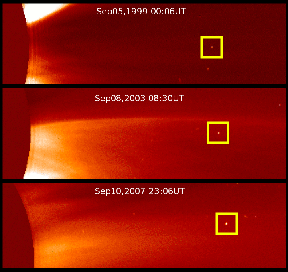
COMETS ARRIVING
2007
Space Weather News for March 20, 2007
http://spaceweather.com
GREEN COMET: There's a new comet in the southern hemisphere: Comet Lovejoy
(C/2007 E2). Terry Lovejoy of Australia discovered it on March 15th using,
remarkably, not a telescope but only an off-the-shelf digital camera. The green
comet is too dim to see with the naked eye, but it is a nice target for backyard
telescopes. After five days of monitoring, the comet's orbit is now known with
some accuracy and it is possible to make predictions about Comet Lovejoy's
future movements and brightness. Visit http://spaceweather.com for details.
|
September 27, 2007
SOHO Mission Discovers Rare Comet

The Solar and Heliospheric Observatory (SOHO) has discovered a rare periodic comet. SOHO has already discovered more than 1,350 comets during its mission, but this is the first time one of its discoveries officially has been designated periodic.
Many of the
comets SOHO has discovered are believed to be periodic, meaning they
follow their orbits around the sun more than twice and have orbital periods of
less than 200 years. Thousands of comets have been seen by astronomers, but only
around 190 are classified as periodic. The most famous periodic comet is
Halley’s Comet, which returns every 76 years. It most recently passed close to
the sun in 1986.
SOHO’s new find has a much smaller
orbit than Halley's Comet. It takes the comet approximately four years to
travel once around the sun. It was first seen in September 1999 and then again
in September 2003. In 2005, German PhD student Sebastian Hoenig realized that
the two comets were so similar in orbit that they might actually be the same
object. To test his theory, he calculated a combined orbit for the comet and
consequently predicted that it would return on Sept. 11, 2007. Hoenig's
prediction proved to be extremely accurate -- the comet reappeared in SOHO's
Large Angle and Spectrometric Coronagraph camera right on schedule and has now
been given the official designation of P/2007 R5 (SOHO). Credit for the original
discovery and recovery of the object goes to Terry Lovejoy (Australia, 1999),
Kazimieras Cernis (Lithuania, 2003) and Bo Zhou (China, 2007).
A puzzling aspect to P/2007 R5 (SOHO) is that it does not look exactly like a
comet. It has no visible tail or coma of dust and gas, as is traditionally
associated with the phenomena. Initially, this led some scientists to wonder if
the object was actually an asteroid, a chunk of space-rock, rather than a chunk
of space-ice. However, P/2007 R5 (SOHO) did exhibit some characteristics
consistent with a comet. As scientists watched the object pass close to the sun,
drawing to within 4.9 million miles, or around 5% of the distance between the
Earth and the sun, they saw it brighten by a factor of around a million, which
is common behavior for a comet.
“It is quite possibly an extinct comet nucleus of
some kind,” says Karl Battams of the Naval Research Laboratory, Washington, who
runs SOHO's comet discovery program. Extinct comets have expelled most of their
volatile ices and retain little to form a tail or coma. They are theorized to be
common objects among the celestial bodies orbiting close to the sun.
This comet faded as quickly as it brightened, and soon became too faint for
SOHO's instruments to see. Estimates show that P/2007 R5 (SOHO) is probably only
100 to 200 yards in diameter. Given how small and faint this object is, and how
close it still is to the sun, it is an extremely difficult target for observers
on Earth to pick out in the sky.
Now we know for certain that P/2007 R5 (SOHO) is there, astronomers will be
watching closely for it during its next return in September 2011.
COMET 17 P - COMET HOLMES
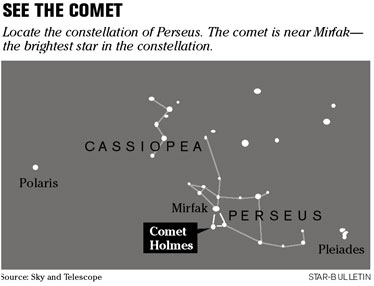
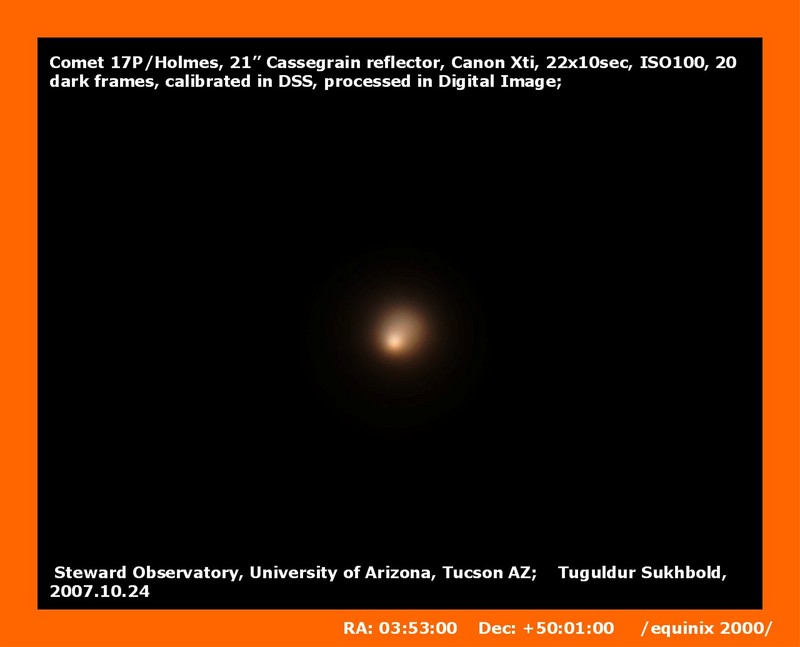
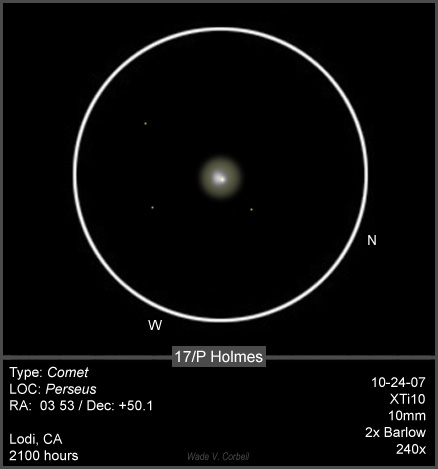
The comet, called 17/P Holmes, has apparently reached the point where it is visible to the naked eye, even near well-lit areas with a near-full moon, amateur astronomers write. Holmes is in outburst mode – a point where a comet releases ice or other particles, increasing its size and reflectivity – but the magnitude of the increase has surprised everyone.
For now, the comet is visible in the Perseus constellation, in the Northern hemisphere. Charts for the astronomically minded can be found here, while the history of the comet, first discovered in 1892, can be found here.
Unfortunately, it's cloudy where I'm sitting, with no sign of clearing in the near future. Here's hoping Holmes keeps bursting.
Discussion at IrishAstronomy.org
Surprise Outburst of Comet Holmes Observed [Bart Busschots]
(Image: A cropped photo of the 17P Holmes outburst, with the coma, or surrounding gas cloud visible. Credit: MrMoorey)
You've probably never heard of Comet 17P/Holmes. That's because it normally shows at a magnitude of around 17, that's about 25,000 times fainter than the faintest star that can normally be seen without any optical aid. In order to view an object this faint, one would need a moderately large telescope.
But overnight, it suddenly brightened to a 3 magnitude, which means it is now very visible. See a photo here.
Comet Holmes was discovered in November 1892 by Edwin Holmes in London England and is not as dramatic as some. Holmes lacks the characteristic tail that makes many of these frozen travelers so beautiful. It is currently located among the stars of the constellation Perseus, which can be found about halfway up in the northeast part of the sky as darkness falls.
Exactly why Comet Holmes has undergone such an incredible transition is not understood. What is amazing is that it made its closest approach to the sun last May, but came no closer than 191 million miles (307 million kilometers) to the sun, reports Space.com. The comet is now moving away from the sun and currently is 151 million miles (243 million kilometers).
Only about 175 actual stars are brighter. As to what this object will do in the coming days and weeks is not known.
STRANGE COMET: Astronomers around the world agree, Comet 17P/Holmes is one of the strangest things ever to explode in the night sky. It's a comet, yet it looks like a planet with a golden core and a green atmosphere:
Chris Shur of Payson, Arizona, took this picture last night using his 12.5-inch telescope and a Canon XTi digital camera. "The comet was yellow and green, very bright in the viewfinder," he says.
Yesterday, Comet Holmes shocked sky watchers with a spectacular eruption, brightening almost a million-fold from 17th to 2.5th magnitude in a matter of hours. The comet is now visible to the naked eye--even from light polluted cities--high in the northern sky after sunset: finder chart.
MEGAOUTBURST STRANGE COMET: Astronomers around the world agree, Comet 17P/Holmes is one of the strangest things ever to explode in the night sky. It's a comet, yet it looks like a planet with a golden core and a green atmosphere...
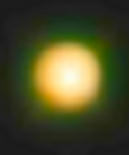 |
HOT NEWS:
Comet 17P/Holmes
shocked astronomers today with a
spectacular eruption. The 17th magnitude comet has brightened by a
factor of five hundred thousand or more during the past 24 hours
becoming a naked-eye object in the evening sky. Look for a golden
2.5th magnitude fuzzball in the constellation Perseus after
sunset. "This is unbelievable!" says Iranian astronomer Babak
Tafreshi. "I was amazed to find Comet Holmes so easily with the
naked-eye in the light-polluted skies of metropolitan Tehran."
Pictures of 17P/Holmes (2007)
More
C/2006
P1(McNaught)
73P/Schwassmann-Wachmann
3
|
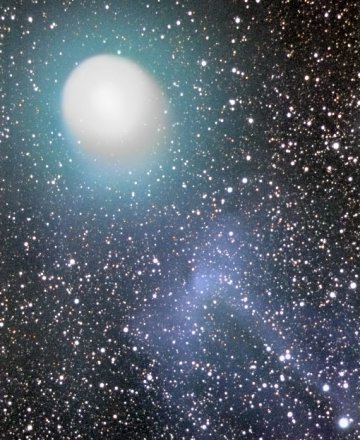
Is Comet 17P/Holmes losing its tail?" asks Italian astronomer Paolo Berardi. "Last night I recorded an image showing a big disconnection event that was not present on Nov 8th."
Jack Newton of the Arizona Sky Village saw it, too: image. "The comet has a huge eruption moving along its tail. Holmes is more bizarre with each passing day."
This event does not necessarily signal a new outburst of Comet Holmes. Comet tails can be disconnected by gusts of solar wind which trigger magnetic storms around the comet akin to geomagnetic storms which fuel auroras on Earth. Such a storm and disconnection was observed earlier this year in the tail of Comet Encke: full story.
Got a telescope? Monitoring is encouraged: sky map, ephemeris.
3D BONUS: Grab your 3D glasses. Graphic artist Patrick Vantuyne has combined two photos of Comet Holmes, one taken by Jack Newton in Arizona and one by Ivan Eder in Hungary, to create an eye-popping stereo portrait: stereo image. "The stereo effect has nothing to do with the different locations of the photographers," he notes. "It is a result of the movement of the comet among between the two pictures."
Comet 17P/Holmes Photo Gallery
[Interactive
World Map of Comet Photos]
[sky
map] [ephemeris]
[3D orbit]
[Night
Sky Cameras]
The Lunar Month of Nov 9, 2007 - Dec 9,2007
Ocurring on the New Moon of Nov 9, 2007
Comet's Tail breaks away.
"COMET TAIL: Exploding Comet 17P/Holmes continues to amaze onlookers. On
Nov. 8th and 9th part of the comet's blue tail broke away in view of
many backyard telescopes. Visit http://spaceweather.com (Nov 10 to see
photos of the "disconnection event" and speculation about what might
have caused it." (Quote from SpaceWeather.com)
The Full Moon of the Nov 9 Lunar Cycle conjoins Comet Holmes and
Mirphak in Perseus An excerpt from the Nov 9, 2007 Lunar Planner: "Comet
Holmes' dramatic eruption in Perseus occurred in the last lunar cycle
(Oct 07). The Full Moon of Nov 24, 2007 significantly conjoins Holmes
while retrograde Holmes and Mirphak conjoin in both ecliptical longitude
and latitude. What a significator! Comet Holmes illumines and
accentuates this Mirphak Full Moon theme; and perhaps our need to
rise-to the occasion as the hero Perseus does in his initiatory journey
to claim the success and achievement that Mirphak embodies. The
realizations this Full Moon offers, whatever they may be for each of us,
may be of extreme significance."
More on Comet Holmes
http://lunarplanner.com/Snippets/snippet.07.11.01-CometHolmes.html
A few topics presented in the Nov 9, 2007 Lunar Planner:
* Relationships in the Balance
* Mars Retrograde begins
* Action - From the Heart of the Swan
* The Opening - The Jupiter Pluto Synodic Cycle & the next 13 years
* The Full Moon: Comet Holmes, Perseus, & the Pleiades
* A Moon Wobble
* Varuna establishes a new order
* Mercury and Juno in Scorpio
* Setting a new course
* Places of the Heart & the Venus bi-polar Vortex
The Lunar Planner
http://www.lunarplanner.com
| Dying comet 73P/Schwassmann-Wachmann 3
continues to break apart. Astronomers are tracking at least 20 fragments
approaching Earth for a harmless but ... www.greatdreams.com/comets/comet-73p.htm |
| The comet of Nostradamus ("great star")
will light up the skies for a week before it strikes Earth. To avoid the
approaching calamity, the pope will flee ... www.greatdreams.com/comets-incoming.htm |
| 7-16-03 - If you've never paid much
attention to comets and asteroids before, ... However, one of these
comets is on a tragectory to hit the moon. ... www.greatdreams.com/lostland/pole2.htm |
| Deep impact spacecraft to 'meet' comet
on July 4: NASA ... The Deep Impact spacecraft is expected to arrive
near Comet Tempel 1 on July 4, one day before . ... www.greatdreams.com/comets_database.htm |
| Editor's note: To me, this looks like
the Sun, earth, and moon and two other space satellites of some kind,
with 4 comets and their trails slamming into the ... www.greatdreams.com/asteroids.htm - |
| On January 24 and 27, 1994, the Hubble
Space Telescope captured the images that went into this mosaic showing
the pieces of Comet Shoemaker-Levy 9. ... www.greatdreams.com/lostland/string-pearls.htm |
| The Solar Forum (Hosted by
Phaeton)Asteroids and Comets (Hosted by Fannie & Tom) ... Comets and
asteroids have been slamming into Earth since time began. ... www.greatdreams.com/1998ox4.htm |
| COMET SWAN: There's a new comet in the
night sky, Comet Swan. At present, it is too dim for the naked eye, but
"the comet is a spectacular sight through ... www.greatdreams.com/incoming_comet_2006.htm |
| A: An asteroid or comet could make the
surface of the Earth very difficult for life. ... Meteor showers are
caused by small particles coming off comets, ... www.greatdreams.com/1950DA.htm |
| Perturbing and consuming the orbiting
motion of asteroids, and Comets, . ... The Solar Forum (Hosted by
Phaeton)Asteroids and Comets (Hosted by Fannie ... www.greatdreams.com/asteroid_database.htm |
DREAMS OF THE GREAT EARTHCHANGES - MAIN INDEX